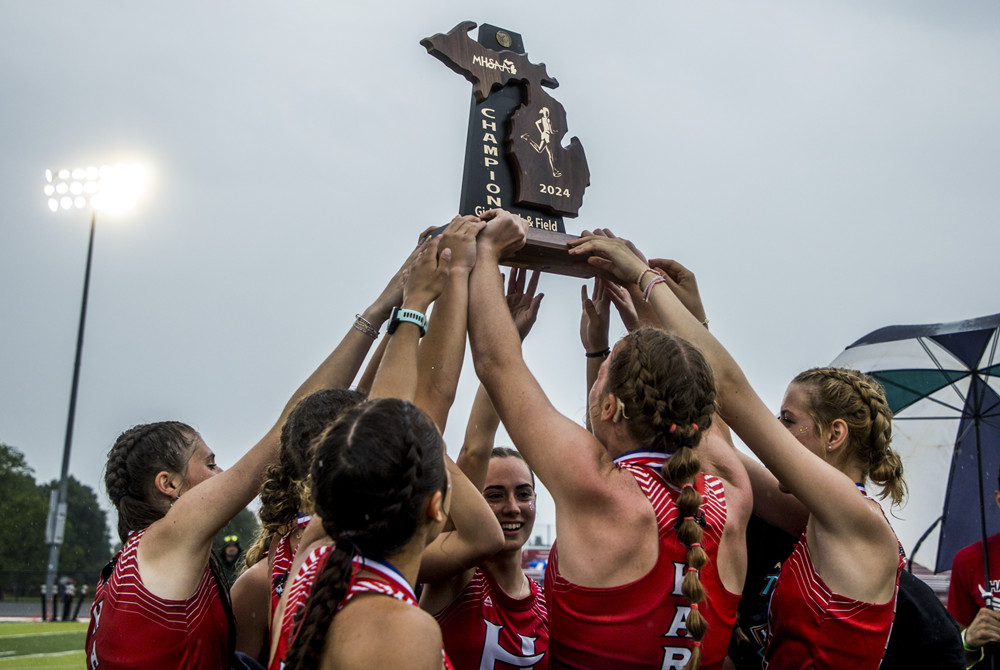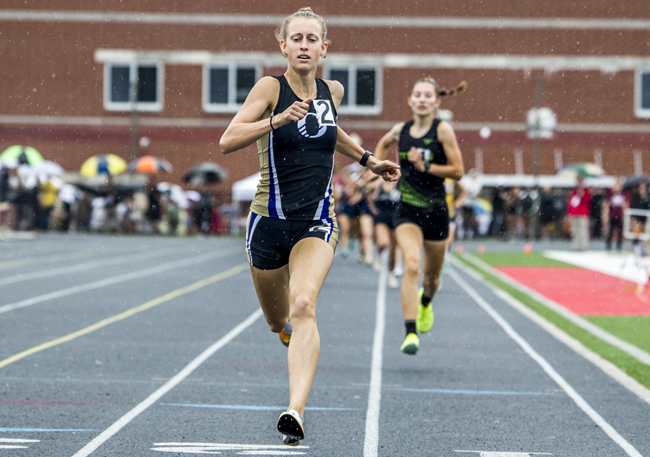
Track Gaining Speed Toward Future with Electronic Starting Devices
By
Steve Vedder
Special for MHSAA.com
May 23, 2023
Aubrey Greenfield thinks it might be the perfect time to reevaluate 130 years of tradition.
For a number of reasons, from technical to personal, the Oxford senior sprinter believes it makes sense for the crack of a starting pistol to be eliminated from high school track meets.
Because track meets would benefit in various ways from lowering costs to easier setup at meets to the human factor of competitors not having to flinch at the crack of a pistol shot, Greenfield believes the sport has a chance to embrace new technology – electronic starting devices (ESD).
In essence, an ESD replaces the starting pistol with a light flash, tone sound or both to begin a race.
"High school sports should put the athlete first," Greenfield said. "We should promote sports, and eliminating starting pistols promotes health in terms of PTSD or trauma for athletes and spectators and that would be good. I would like to think people would say that's a good idea."
In fact, Greenfield would go as far as to say if there was not an implementation of electronic starting devices, many of her teammates would have considered giving up the sport.
"If it's something that helps us compete safely, we're all for it," she said.
Greenfield's opinion apparently is spreading. Michigan High School Athletic Association senior assistant director Cody Inglis said the use of ESD makes it both affordable for meet starters and sensible for athletes and fans to rethink the use of starting pistols. While the MHSAA is not mandating electronic starting devices, it does promote the use of what Inglis calls "emerging technology." He notes that ESD are becoming the norm for organizations such as USA Track & Field, the NCAA and an increasing number of high schools.
 "I think we have to embrace new technology, and we think this will be something that takes hold," Inglis said.
"I think we have to embrace new technology, and we think this will be something that takes hold," Inglis said.
A key part of embracing ESD is the human element. The tragic Oxford High School shooting Nov. 30, 2021, that took the lives of four students while injuring seven others should not be relived even for a fleeting instance at a high school sporting event. Oxford athletic director Tony DeMare said the school began using ESD at every meet, including the MHSAA Lower Peninsula Division 1 Finals last June. He said that decision was embraced by virtually all schools Oxford encountered.
"We were very convinced that the alternative (of ESD) would promote a healthy attitude," DeMare said. "We were overwhelmed with the positive response. If a school was on the fence about it or might not be for it, I think we've started to see the tide turn in favor of people willing to listen and learn about electronic starting devices."
Inglis said the MHSAA is acutely aware of what the crack of a starting pistol can mean to athletes and fans.
"It's unimaginable what Oxford went through, and this is a small way we can help," he said. "We look at a (starting pistol) and think, ‘Could we do something else?’ It's a way of helping to solve a problem."
Over the last several years, the MHSAA has embraced finding an alternative to starting pistols. Inglis noted the discussion started with the cost and diminishing availability of 32-caliber ammunition that meet starters use. A box of ammunition, if it can be found, is around $75 a box.
In addition to cost, there is potential damage from excessive exposure to 150-plus decibels of sound generated by the traditional 32-caliber blanks. Medical studies show damage to ears caused by decibel levels above 120 dB.
The tragedy at Oxford accelerated the conversation.
Inglis said the cost of ESD can be likened to a school sinking money into artificial surfaces at football fields. Yes, there is a great cost at first, but over time money is ultimately saved. An ESD system itself ranges between $200 and $500. Speakers also may need to be purchased, but with ESD starting events like the 800 and 1,600-meter relays positioned near the outside lanes 8, 7, 6 and 5 would result in improved hearing by athletes at the start of a race.
There is one challenge with ESD that track administrators are working to overcome – lighting conditions that lessen the ability to see the ESD’s LED light or strobe when the button is pressed by a starter to begin a race. But that vision difficulty resulting from clear blue skies and backgrounds of setting suns can be substantially improved by incorporating a black background with an ESD – something as simple as a starter holding up black cardboard behind the lighting mechanism at the start of an event.
Inglis said when all factors are considered, the use of ESD makes sense.
 "With the climate we live in nowadays, no lookalike guns is good," he said. "We're not mandating this. But people are saying this is affordable."
"With the climate we live in nowadays, no lookalike guns is good," he said. "We're not mandating this. But people are saying this is affordable."
While switching to ESD would break 130 years of tradition, the timing could be a step forward, said Jeff Hollobaugh, co-author of the book "The Fleet Feet of Spring: Michigan's High School State Championships in Track & Field." He said while no definitive answer is possible, it's likely starting pistols were used at the inaugural state meet at the Jackson Fairgounds in 1895. The meet, which included events like tossing a 16-pound shot put, bike races and a 100-meter sprint, was sponsored by the Michigan Interscholastic Athletic Association (a predecessor to the MHSAA) and comprised mostly of the state's larger schools.
Hollobaugh's sentiments echo what many involved in today's high school track & field believe in terms of making a transition from starting pistols to electronic starting devices.
"It's a change, not necessarily good or bad, just different," he said. "It's not a drastic change, but it will take some getting used to. But it is the future. In the end, we'll all be fine."
DeMare believes the future of high school track will definitely include ESD.
"Our desire is that the practicality and sensibility of this will overcome the alternative," he said. "I think we'll see the automation and electronics taking hold of certain elements in track, and people will embrace it."
PHOTOS (Top) Runners watch official Bertha Smiley as they prepare to begin a race during last season's Lower Peninsula Division 1 Finals at Rockford. (Middle) An electronic starting device provided by VS Athletics was used to start those races. (Below) Smiley sets to begin an event. (Photos provided by David Kuderka/VS Athletics.)

Hovey Leads Hart to Historic 3-Peat, Onsted's Ross Joins Prestigious 4-Win Group
By
Dean Holzwarth
Special for MHSAA.com
June 1, 2024
KENT CITY – Addison Hovey was a dual threat Saturday for the Hart girls track & field team.
The junior standout used blazing speed, combined with remarkable leaping ability, to help spark the Pirates to a third-straight title at the Lower Peninsula Division 3 Finals, held at Kent City High School.
Hovey captured wins in the 100 and 200, while also winning the high jump for a second straight year.
“Winning high jump was my main priority, and then top eight in the 100 and 200,” Hovey said. “But I’m honestly so surprised because I knew there were really good girls in those two events.
“I’m just really proud of how much work I’ve put in this season, and it showed today and paid off.”
Hart became the first Division 3 girls team to win three consecutive championships. The Pirates finished with 53 points, while Onsted (40) was runner-up and Olivet (38) took third.
“It means the world to me and my team,” Hovey said. “No team in Division 3 had won three years in a row, so that’s huge. We lost one of our really good athletes, and she was a big part for us, so we knew there was going to be some pressure coming into this. I’m really proud of my teammates. The girls stepped up and helped me.”
 Last season’s 3,200 winner, Jessica Jazwinski, was unable to compete for most of this season.
Last season’s 3,200 winner, Jessica Jazwinski, was unable to compete for most of this season.
“I really didn't expect this part way through the season,” Hart coach Calvin Ackley said. “Especially because a couple distance runners, one went out, and one was coming back from injury. Traditionally, we’ve been distance, distance at Hart. I never thought I’d see the day we would be dominating in sprints. That’s been exciting, and my coaches are fantastic.”
Hovey out-jumped Kalamazoo Christian’s Ellie VanDusen by eclipsing 5-foot-6 to tie the LPD3 Finals record. Hovey also recorded a personal-best time of 12.27 in the 100 and ended her day with an impressive 25.60 in the 200.
“I was so tired, but I just gave it my all,” Hovey said. “It was the last event of my last meet. Hopefully I feel better tomorrow.”
Ackley said Hovey’s improvement over the past few years has been remarkable.
“Absolutely amazing day,” he said. “She’s come a long way from a freshman kind of unsure of herself to an absolute beast.
“She’s an amazing athlete and has a great attitude. She doesn't worry about the little things that don't matter. She just focuses on what she needs to do, and she carried the team today. She just keeps progressing, and she’s a great basketball player, but a fantastic track athlete.”
Junior Emmry Ross also shined, winning all four of her events to single-handedly place Onsted second as a team. She racked up repeat victories in the 400 and 800, while also claiming titles in the 1,600 and 3,200 – becoming just the seventh girl all-time (and third in the Lower Peninsula) to win four events at an MHSAA Finals.
“Honestly, I went into today pretty nervous,” Ross said. “I was more nervous last night than I was today because today I just went in with the mindset of, ‘Do my best. You got here. You deserve this.’ I worked really hard this season, and I just went in and had confidence. It turned out to be a really good day, and it was fun because I got to run in the rain.”
Ross said running four events wasn’t grueling because of her preparation.
“I train for it,” she said. “I ran those four (events) at Regionals and two other meets before that, so I was used to it. It wasn’t a challenge because I’ve done it before.”
While those two combined to win the majority of Saturday’s individual running events, Kalamazoo Christian freshman Elli VanDusen (110 hurdles) and Olivet sophomore Emily Peters (300 hurdles) claimed titles as well. Monroe St. Mary Catholic Central (400), Olivet (800) and Jackson Lumen Christi (1,600 and 3,200) won the relays. Montrose freshman Addyson Stiverson (shot put) and Grayling senior Rylan Finstrom (discus) were first in the throws, Wyoming Potter’s House Christian junior Sohanny Gonzalez-Castillo won the long jump and Homer junior Emma Wildt won the pole vault.
PHOTOS (Top) Hart celebrates its third-straight Division 3 championship Saturday at Kent City. (Middle) Onsted’s Emmry Ross crosses the finish line for one of her four individual victories. (Click for more from Jamie McNinch/RunMichigan.com.)

